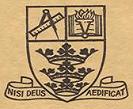
SIR CHRISTOPHER WREN TECHNICAL HIGH SCHOOL

SIR CHRISTOPHER WREN (1632 - 1723)
Some short time ago the school was given a new name and it therefore seemed apposite to include in the magazine a brief account of that most remarkable man and, probably, the most famous of British architects.
Wren was the son of a clergyman and was born at East Knoyle in Wiltshire, October 20th 1632. He entered Wadham College, Oxford, in 1646 and took his degree in 1650. It was during his time at the University that Wren distinguished himself in Geometry and applied Mathematics, and the great Isaac Newton speaks very highly of him in his Principia in 1713. In 1657 Wren became Professor of Astronomy at Gresham College, a side of his learning not generally known, but this is quite overshadowed by his fame as an architect.
Charles 11 had approached Wren in 1665, one year before the Great Fire, to repair and restore the old Gothic-style church of St. Paul’s in London but the “Fire” occurring in 1666 utterly destroyed the old church, thus giving Wren a free hand in the design which we know so well today. It is considered by experts that Wren’s arrangement of two heights of columns makes the exterior of St. Paul’s vastly superior to that of St. Peter’s, which is dwarfed by the enormous size of the columns in single order.
The first stone of St. Paul’s was laid on 21st June 1675 and the last stone was set in 1710. After the destruction of the City of London, Wren was employed to redesign its fifty burnt churches. He also laid out a plan for the replanning of London on a wide and grand scale, but the difficulty of ownership of land frustrated this. He was also a Member of Parliament for many years - another side of his life’s work not generally known. He died in 1723 and is buried under the choir of St. Paul’s
HOUSE NAMES
The school now possesses names for the various houses. These names have been taken from those well known families dwelling, or having close connections with, the East Riding. Owing to its location the East Riding, shut off by the Humber to the south and to the east by the North Sea, tend to become somewhat of a historical backwater and it is not until one delves into the records of the area that most interesting facts are discerned which prove that its great people were not historically secluded even if they were geographically.
It is not generally known that had the Battle of Bosworth Field ended in victory for the courageous Richard 111, then a Hull man, one of the De la Poles, would possibly have been the next king of England.
However, it is not our intention to dwell on the past in general, but purely with regard to our houses, and we honour the school by the choice of names. Below will be found a brief history, by necessity much curtailed, of three of the famous family names. It is hoped to follow these three accounts with those of the three remaining in our next issue.
The Sykes Family
The Sykes family live at Sledmere in Yorkshire. One notable fact connected with the family is that for several generations in succession the head of the family has been remarkable in some way or other.
The baronetcy was created in 1783 on the Rev. Mark Sykes, then Rector of Roos in Holderness, but he only lived a few months to enjoy it.
He was succeeded by Christopher, who married Elizabeth, daughter of William Tatton of Withernshaw, Cheshire. This baronet represented Beverley in the Parliament from 1784 to 1790.
When Sir Christopher inherited Sledmere estate, the Yorkshire Wolds were very different from the present day. There are probably few country districts in England which have changed more than this since the beginning of the last century.
It is probable that in ancient times no timber grew upon the Wolds; had it been otherwise the tract of country was so extensive there would now almost be some trace of it.
Sir Christopher Sykes died in 1801 and was succeeded by his son Mark, who took the name of Masterman, before his own, on succeeding to the Battrington estates after his marriage to a daughter of Mr. Henry Masterman of that place.
He collected a very good library at Sledmere House. He died without issues in 1823. After his death the library was sold in London by auction and realised about £10,000. His pictures were also similarly sold, one by Salvato Rosa realizing 2,100 guineas - a large sum in those days.
He was succeeded by his younger brother Tatton, who remained unmarried till he had reached the age of fifty. The youngest brother, the Rev. Christopher Sykes, was married but had only a family of daughters; and so the estate was entailed on the male issue of the two sisters of Sir Tatton, one of whom was married to a certain Mr. Foulis, and the other to Mr. Wilbraham Egerton of Tatton Park, Cheshire
Sir Tatton was an excellent man of business and was able to leave savings to the amount of £500,000, the whole of which was in the funds.
Sir Tatton was a great sportsman and was a keen folloer of the Hunt. He was born at Wheldrake, 22nd August, 1772, and died on 21st March 1863. He was buried in the churchyard at Sledmere. There is probably no one in this or any other generation who has spent so much money on church work at the late Sir Tatton Sykes, and his name in this connection will be held in grateful memory for generations to come. Sir Tatton (4th Baronet) established Dame Schools in some villages and placed intelligent men or trained teachers in charge of the others, bearing the whole cost. When he died the good work was carried on for their son, Sir Tatton, by Miss Sykes.
Sir Tatton (5th Baronet) disliked to see flowers growing in the cottage gardens. Sir Tatton once met an old sexton of Wansford and suggested to him that he should grow vegetables instead of flowers, to which the old man replied “Whya, Sir Tatton, if ya tak t’floores you’ll a’e ti tak mah au’d womn an ‘all”
At the age of forty-eight Sir Tatton married the eldest daughter of the Rt. Hon. George A. Cavendish-Bentinck, M.P. for Whitehaven, by whom he had one child, Mark, who succeeded him in the baronetcy and estate.